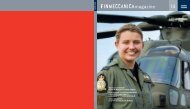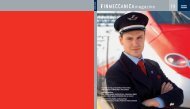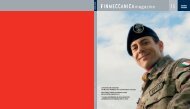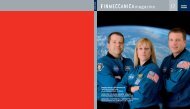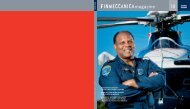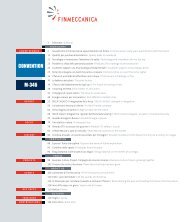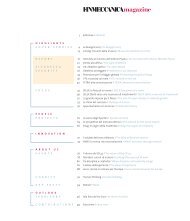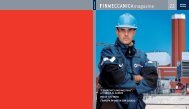E - Finmeccanica
E - Finmeccanica
E - Finmeccanica
You also want an ePaper? Increase the reach of your titles
YUMPU automatically turns print PDFs into web optimized ePapers that Google loves.
H I S T O R Y<br />
9/2010 FINMECCANICA MAGAZINE<br />
his way to becoming the legend that<br />
no rider has ever equalled and that<br />
perhaps no-one ever will. The racing<br />
division continued to rack up victories<br />
but required huge financial investment.<br />
Furthermore, the manufacture<br />
of production models was not able to<br />
repeat the early successes, although<br />
the extraordinary sporting achievements<br />
of MV models acted as a showcase<br />
for the MV name. Italians of the<br />
1960s economic boom period increasingly<br />
set their sights on the car and<br />
no longer wanted cheap motorcycles.<br />
MV’s motorcycle division was continuously<br />
being subsidised by income<br />
from aeronautics, which was very successful<br />
at the time (the agreement<br />
with US company Bell in 1952 for the<br />
construction under licence of AB47G<br />
helicopters was a fundamental turning<br />
point). The company continued to<br />
struggle on until deciding in 1962 to<br />
reduce the number of models in its<br />
range and to cut production costs.<br />
Despite the crisis, Count Agusta still<br />
wanted to surprise, and in 1965 the<br />
extraordinary 500 was finally produced:<br />
in the meantime, the displacement<br />
had increased to 600cc (a 750cc<br />
model would be produced in 1970),<br />
and the machine boasted a double<br />
disk brake, 52 HP at 8,000 rpm and a<br />
top speed of 177 km/h. Only 310 were<br />
produced at a price of 1,060,000 lire,<br />
twice that of a Guzzi V7 motorcycle.<br />
On 2 February 1971, Domenico Agusta<br />
died. He was succeeded in the company<br />
by his brother Corrado. The company’s<br />
financial problems increased to<br />
such an extent that in early March<br />
1973, 51% of the Varese-based company<br />
was transferred to the stateowned<br />
EFIM. Following the Count’s<br />
death and as a result of the greater<br />
contribution made by aeronautics,<br />
motorcycles came to be of less importance<br />
and less interest within Agusta,<br />
and in 1978 production was halted<br />
and the company put into liquidation.<br />
The renaissance of the MV motorcycle<br />
came about 20 years after the<br />
Cascina Costa plant closed down<br />
thanks to brothers Claudio and Giovanni<br />
Castiglioni, who, after relaunching<br />
Ducati, announced in<br />
spring 1992 that they had bought the<br />
MV Agusta brand. There were no motorcycles<br />
or technical fittings to be<br />
recovered, not even the GPs that<br />
Agostini and his team mates once<br />
raced in competitions. These unique<br />
items were however saved thanks to<br />
the restoration work carried out by a<br />
group of former Agusta employees,<br />
and now have pride of place in the<br />
Cascina Costa museum. Claudio, the<br />
more avid motorcycle enthusiast of<br />
the Castiglioni brothers, spearheaded<br />
the resurgence of MV: the motorcycles<br />
would be built in Schiranna,<br />
Lake Varese, not far from Cascina Costa.<br />
To design the new range of MVs,<br />
the great motorcycle manufacturer<br />
Cagiva chose Massimo Tamburini, a<br />
veritable genius of the motorcycle,<br />
who had designed the Ducati 916,<br />
the most beautiful sports superbike<br />
of the second millennium. Tamburini<br />
did not disappoint, and created another<br />
masterpiece: the MV Agusta<br />
F4. It fell to Giacomo Agostini to unveil<br />
the model at the Milan Motorcycle<br />
Show 1997, where the public were<br />
truly amazed by such a pure, radically<br />
sporty and uncompromising line,<br />
just as a motorcycle built for speed<br />
should be: in short, a truly Italian motorcycle.<br />
It has a transverse inline<br />
four-cylinder 750cc engine designed<br />
by engineers at Cagiva with initial assistance<br />
from Ferrari Engineering,<br />
Maranello’s technology division, and<br />
is notable for the use of radial valves,<br />
a cassette gearbox, single-arm front<br />
fork in light alloy and four-pipe undertail<br />
exhaust. Then came the Brutale<br />
750, the naked bike that also<br />
bore the Tamburini signature. It immediately<br />
became the benchmark in<br />
the naked category thanks to the<br />
beauty of its line and its absolute<br />
performance. The resurgence of the<br />
MV Agusta also came via the sale of<br />
Ducati to US fund TPG (Texas Pacific<br />
Group) in 1997. This injection of cash<br />
served to support the new financial<br />
and industrial commitment, but was<br />
not enough to keep the company<br />
afloat and craft the extraordinary<br />
motorcycles that Castiglione had in<br />
mind. Following an interval that saw<br />
interest in MV from both the Piaggio<br />
Group and Malaysian company Proton,<br />
although the latter only remained<br />
at the Lake Varese location<br />
for little more than two years, in<br />
mid-July 2008 Harley-Davidson announced<br />
it had signed an agreement<br />
to revive the MV Agusta and Cagiva<br />
brands, leaving the management<br />
and development of the new motorcycles<br />
in the hands of Claudio Castiglioni.<br />
This meant that plans that<br />
had been on ice for some time could<br />
now emerge from the computers of<br />
the Varese-based engineers. These<br />
included the new F4 1000 – the original<br />
model has been in the catalogue<br />
for 12 years, a record for sports bikes<br />
– and the prototypes of the 3-cylinder<br />
675cc naked and sports models.<br />
But after just one year, the American<br />
dream evaporated following the severe<br />
crisis suffered by Harley Davidson,<br />
which saw its sales plummet<br />
from 350,000 motorcycles delivered<br />
around the world in 2006 to 223,000<br />
last year. This has led to the decision<br />
to sell MV Agusta to concentrate on<br />
their two-cylinder machines. However,<br />
there are no fears for the future<br />
at Schiranna given that in early August<br />
Claudio Castiglioni regained<br />
ownership of this glorious brand.<br />
With Castiglioni at the helm, the<br />
company will emerge from the crisis<br />
even stronger than before to build<br />
ever more beautiful, fast and exclusive<br />
machines.<br />
AERMACCHI ON TWO WHEELS:<br />
THE ‘DOWN-TO-EARTH’ HISTORY<br />
OF A CHAMPION OF FLIGHT<br />
Cigno, Chimera, Ala d’Oro, Aletta.<br />
These almost celestial names<br />
symbolise the history of Aermacchi,<br />
but it is a huge three-wheel truck<br />
that represents the initial expression<br />
of what the fast motorcycles<br />
that would be built on Lake Varese<br />
would come to embody. In its efforts<br />
to convert to a peace-time industry,<br />
Aermacchi decided, in common<br />
with all other aeronautics<br />
companies – as Piaggio did with its<br />
Vespa – to embark on a route of<br />
utilitarian transport and entrusted<br />
its design for a three-wheel truck to<br />
Ermanno Bazzocchi, one of its most<br />
brilliant engineers. The designer<br />
from Tradate, to whom we owe Aermacchi’s<br />
exquisite trainer aircraft –<br />
especially the MB-339 – in 1945 designed<br />
the MB1, a revolutionary<br />
mode of transport for its time: it<br />
had a closed cabin, car-style steering<br />
wheel, front suspension derived<br />
from aircraft undercarriages, large<br />
load capacity, and a 750cc 23-HP<br />
4–stroke boxer engine. The truck<br />
was a success and saved the company<br />
from closing, after which it remained<br />
in production for nearly 30<br />
years. The first real Aermacchi motorcycle,<br />
the Cigno, was unveiled at<br />
the Milan Motorcycle Show in 1951.<br />
Appearing at the height of the<br />
scooter boom, it captured all the<br />
scooter’s best features: plate bodywork<br />
that did not dirty the rider’s<br />
clothes, storage space and an economical<br />
125cc 2-stroke engine that<br />
travelled 40 km on one litre. These<br />
functional qualities were supplemented<br />
by the safety of driving a<br />
motorcycle thanks to the large 17-<br />
inch wheels. However, it was too<br />
much of a hybrid machine to be really<br />
pleasing: it was sold at a price<br />
of 165,000 lire, one thousand more<br />
than the Vespa. Aermacchi’s motorcycling<br />
fortunes were slow to take<br />
off: in 1956, the company unveiled<br />
the Chimera 175, an innovative and<br />
streamlined motorcycle, but it was<br />
ahead of its time. Stripped of its unappreciated<br />
livery, the Chimera<br />
gave up its 4-stroke horizontal<br />
cylinder engine to the lucky series<br />
of motorcycles whose names began<br />
with Ala: the Ala Verde 250 of 1959<br />
was the sportiest Italian motorcycle<br />
of its time, while the Oro launched<br />
a generation of independent racers.<br />
In 1960 came the agreement with<br />
Harley-Davidson to build small<br />
bikes, which gave rise to the 2-<br />
stroke 125s such as the Aletta (1967)<br />
and the Aermacchi GTS 350 Turistica.<br />
In 1972, Aermacchi, which had<br />
gone back to aircraft construction<br />
as early as 1947, abandoned the motorcycle<br />
for reasons connected both<br />
with the decline in the sector and<br />
its increasing commitment to<br />
building military aircraft. The company<br />
was now completely American-owned,<br />
as AMF had acquired<br />
Harley-Davidson in the meantime.<br />
In 1978, AMF-Harley Davidson left<br />
Schiranna, and in the autumn of<br />
that year, Claudio and Gianfranco<br />
Castiglioni identified the former<br />
Aermacchi premises as the place to<br />
establish Cagiva, build Swedish<br />
Husqvarna off-road bikes and restart<br />
production of beautiful MV<br />
Agusta models.<br />
Above and top left: the latest version of the F4.<br />
Top: the Chimera 175 from 1956.<br />
It has a 998cc 4-cylinder engine, maximum<br />
Above and right: the Cigno 125, 1951<br />
engine horsepower of 186 HP, traction control<br />
and empty weight of 192 kg.<br />
Top right: the MV Agusta Sport Ipotesi 350 of<br />
1976. The line is designed by Giugiaro<br />
52 53



